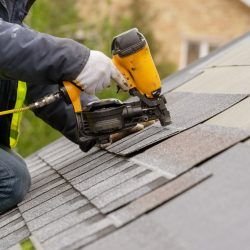Roofing – Level 2
About this course
Roofing – Level 2 Course
Module 1: Advanced Safety & OSHA Compliance
Fall Protection Systems (harnesses, guardrails, anchor points)
Hazard Recognition & Mitigation (chemical exposure, electrical hazards)
Ladder & Scaffold Safety (proper setup, load limits)
Emergency Procedures (first aid, fire safety, rescue plans)
OSHA 10-Hour Certification Prep (roofing-specific standards)
Module 2: Commercial & Residential Roofing Systems
Asphalt Shingles (advanced cuts, valleys, ridge vents)
Metal Roofing (standing seam, corrugated, fastener techniques)
Single-Ply Membranes (TPO, PVC, EPDM) (adhesive vs. mechanical attachment)
Modified Bitumen (torch-down & cold-applied methods)
Tile & Slate Roofing (proper underlayment, cutting, installation)
Module 3: Waterproofing & Flashing Techniques
Roof Flashing Types (step, counter, drip edge, pipe boots)
Leak Prevention Strategies (ice & water shield, sealants)
Chimney, Skylight & Vent Flashing (best practices for watertight seals)
Membrane Seaming & Welding (hot air, chemical, and tape methods)
Module 4: Roof Repairs, Maintenance & Estimating
Leak Detection & Troubleshooting (common failure points)
Patching & Re-Roofing Techniques (shingle replacement, membrane repairs)
Material Estimation (calculating squares, waste factors)
Reading Blueprints & Roof Plans (slope, drainage, penetrations)
Module 5: Green Roofing & Industry Best Practices
Cool Roofing & Reflective Coatings (energy efficiency)
Solar-Ready Roofing (integration with PV panels)
Sustainable Materials (recycled shingles, eco-friendly membranes)
Final Hands-On Project (full mock roof installation/repair)
Assessment & Certification
Written Exam (safety, materials, techniques)
Practical Skills Test (flashing, membrane welding, shingle installation)
Optional Certifications (OSHA 10, NRCA ProCertification prep)
This 5-module structure ensures a balanced mix of theory, hands-on training, and industry best practices for Level 2 roofers.
Comments (0)
Advanced safety and OSHA compliance involve going beyond basic requirements to proactively manage workplace hazards and create a robust safety culture. It includes implementing systems, training programs, and technologies to identify and mitigate risks, ensure compliance with OSHA standards, and foster a culture where safety is a top priority.
Waterproofing involves applying materials to prevent water from entering a structure, while flashing is the process of installing thin, impervious materials to seal seams and joints, especially around roof penetrations like chimneys and vents. Proper waterproofing and flashing techniques are crucial for preventing water damage, mold growth, and structural issues.
Roof repair, maintenance, and estimating involve a range of services to address and prevent issues with your roof. RoofSnap offers a helpful guide on how to estimate a roofing job, covering steps from pre-check to delivering the estimate.
Connecteam provides a cost calculator for roof repairs, noting that costs vary based on factors like damage severity, roof size, and labor.
Green roofs, also known as living roofs, are built on top of buildings and utilize plant life to provide a variety of benefits. Best practices in green roofing involve careful planning and execution, including proper roof inspection and preparation, waterproofing, drainage system installation, selecting appropriate vegetation, and regular maintenance.





